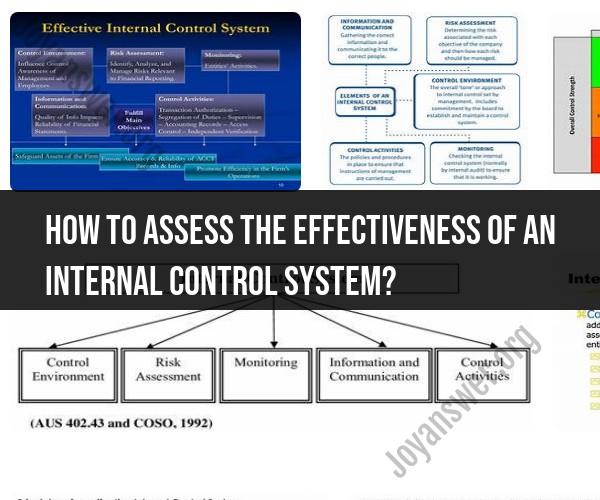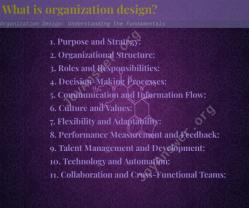How to assess the effectiveness of an internal control system?
Assessing the effectiveness of an internal control system is a critical part of ensuring that an organization's operations are conducted efficiently, reliably, and in compliance with relevant regulations. Here are steps and methods to evaluate the effectiveness of internal control systems:
Understand the Objectives and Scope:
- Begin by understanding the objectives of the internal control system. What is it designed to achieve, and what processes and activities does it cover? Define the scope of your assessment.
Review Documentation:
- Examine the documentation related to the internal control system, such as policies, procedures, manuals, and guidelines. Ensure that these documents are up to date and accurately reflect the current processes.
Identify Key Controls:
- Identify the key controls within the internal control system. These are the controls that are critical for achieving the system's objectives and mitigating significant risks.
Assess Design Effectiveness:
- Evaluate the design effectiveness of the key controls. Determine whether the controls are well-designed to achieve their intended objectives. Consider factors like the segregation of duties, authorization processes, and workflow.
Evaluate Operating Effectiveness:
- Assess the operating effectiveness of the key controls by testing them in action. This can involve conducting sample transactions and verifying that the controls operate as intended. For example, if a control is meant to prevent unauthorized access to data, test whether it successfully restricts access.
Assess Documentation and Records:
- Review records and documentation to ensure that transactions and activities are properly recorded, and evidence of control implementation is available.
Perform Risk Assessment:
- Conduct a risk assessment to identify potential weaknesses or gaps in the internal control system. Consider factors such as changes in the business environment, emerging risks, and new regulatory requirements.
Gather Feedback:
- Seek feedback from employees who are involved in the processes covered by the internal controls. Their insights can provide valuable information about how well the controls are functioning and where improvements may be needed.
Review Incidents and Exceptions:
- Analyze past incidents, exceptions, or control failures. Understand the root causes of these issues and assess whether they were due to control deficiencies.
Consider External Auditors' Findings:
- If external auditors are involved, review their findings and recommendations regarding the internal control system. Address any issues they have identified.
Document Findings:
- Document your assessment findings, including any weaknesses or deficiencies identified. Categorize them by severity and prioritize them for remediation.
Develop an Action Plan:
- Create an action plan to address the identified weaknesses and deficiencies. Define specific corrective actions, assign responsibilities, and establish timelines for resolution.
Implement Improvements:
- Implement the necessary improvements and enhancements to the internal control system based on the action plan. Ensure that changes are well-documented and communicated to relevant stakeholders.
Monitor and Review:
- Continuously monitor and review the effectiveness of the internal control system. Regularly update your assessments and make adjustments as needed to address changing risks and circumstances.
Independent Validation:
- Consider having an independent party (internal audit or an external consultant) validate the assessment of internal controls to ensure objectivity and thoroughness.
Evaluating the effectiveness of an internal control system is an ongoing process that requires vigilance and a commitment to improvement. It is essential for organizations to maintain a strong control environment to safeguard assets, ensure compliance, and enhance operational efficiency.
Assessing Internal Control System Effectiveness: Key Principles
There are a number of key principles that should be considered when assessing the effectiveness of an internal control system. These principles include:
- Relevance: The internal control system should be relevant to the organization's objectives and risks.
- Effectiveness: The internal control system should be effective in preventing or detecting and correcting material misstatements.
- Efficiency: The internal control system should be efficient and cost-effective.
- Flexibility: The internal control system should be flexible enough to adapt to changes in the organization's environment and operations.
- Integrability: The internal control system should be integrated with the organization's overall management system.
The Audit Perspective: Evaluating the Efficiency of Internal Controls
Auditors evaluate the efficiency of internal controls by assessing the following factors:
- The design of the internal control system: Is the system well-designed and appropriate for the organization's objectives and risks?
- The implementation of the internal control system: Are the controls being implemented as designed?
- The effectiveness of the internal control system: Are the controls effective in preventing or detecting and correcting material misstatements?
Auditors use a variety of methods to assess the effectiveness of internal controls, including:
- Interviews: Auditors interview management and other personnel to understand the organization's internal control system and to identify any potential weaknesses.
- Observation: Auditors observe employees performing key tasks to ensure that the controls are being implemented as designed.
- Testing: Auditors test the effectiveness of controls by performing procedures such as:
- Performing analytical procedures to identify unusual fluctuations in data.
- Examining documentation to ensure that it is complete and accurate.
- Retesting controls that were found to be ineffective in the past.
Enhancing Business Operations: Strategies for Effective Internal Control Assessment
There are a number of strategies that organizations can use to enhance their business operations through effective internal control assessment. These strategies include:
- Involve management: Management should be involved in all aspects of the internal control assessment process. This includes identifying and assessing risks, designing and implementing controls, and monitoring the effectiveness of the internal control system.
- Use a risk-based approach: The internal control assessment should be focused on the organization's most significant risks. This will help to ensure that the organization's resources are allocated to the areas of greatest need.
- Use technology: Technology can be used to automate and streamline the internal control assessment process. This can help to reduce costs and improve efficiency.
- Get regular feedback: The organization should obtain regular feedback on the effectiveness of its internal control system from auditors and other stakeholders. This feedback can be used to improve the system over time.
By following these strategies, organizations can enhance their business operations through effective internal control assessment.
Here are some additional tips for effective internal control assessment:
- Document the internal control system: The internal control system should be documented so that it is understood by all employees.
- Monitor the internal control system: The internal control system should be monitored on a regular basis to ensure that it is effective and up-to-date.
- Update the internal control system as needed: The internal control system should be updated as needed to reflect changes in the organization's environment and operations.
Effective internal control assessment is essential for organizations of all sizes. By following the key principles and strategies outlined above, organizations can enhance their business operations and reduce the risk of fraud and other errors.











